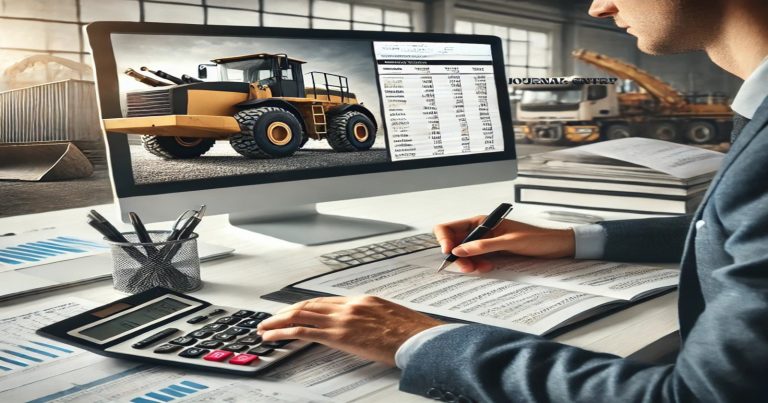Acquiring fixed assets, such as a new machine, is one of the most common and crucial transactions in any business. The entry represents the purchase of machinery that can be recorded in the books of accounts. Spending money by cash, by cheque or on credit all require different journal entries but they are specific to each case. It is the purchase of machinery and its entry that includes the debit of a machinery account (as it is an asset) and credit for the payment method (such as cash, bank, or creditor). You should see machinery for what it is — it is not an expense. It’s a capital asset, so it’s not an immediate hit to the profit and loss account. Instead it goes on the balance sheet as part of fixed assets. You need to be extra careful while recording for machinery purchased journal entry. It reports the actual worth of your book assets. The entry also depends on the way the business makes the payment. You will learn how to post journal entry for purchase machinery (purchase machinery for cash journal entry, purchase machinery on credit journal entry and purchase machinery by cheque journal entry.
Meaning and Basics of Machinery Purchased Journal Entry
Before you know the types of entries, you need to know (why this entry matters) Every time a business buys machinery, printed on fixed assets. That means the company will deploy it for years. Hence, you need to write the machinery purchase in the asset side of the balance sheet. This is where the machinery purchased journal entry comes into play.
How to Record Journal Entry of Machinery Purchased?
In accounting, we always debit in what comes in and credit out what goes out. Machinery enters, you will debit the machinery account. It means that payment goes out, so you will credit the payment method.
Here’s the general format:
| Journal Entry | Debit (₹) | Credit (₹) |
| Machinery A/c DrTo Cash/Bank/Creditor A/c(Being machinery purchased) | xxx | xxx |
Running balance line variable can make the credit side variable based on payment.
Now, let’s go through each type of journal entry for machinery purchases with implementation and examples.
Machinery Purchase Journal Entry for Cash
In case a business purchases the machinery and pays cash such business should record the purchase machinery for cash journal entry. This is true in most cases in small businesses and shops. Your data are supposed to treat machinery as an asset instead of an expense. Debit machinery account and credit cash account (as cash goes out). It is recording everything that happens in the company and how money was decreased. You should retain the attached invoice and proof of payment for audit purposes. If so, follow this format:
Journal Entry Format:
| Journal Entry | Debit (₹) | Credit (₹) |
| Machinery A/c DrTo Cash A/c(Being machinery purchased for cash) | xxx | xxx |
Example:
Example: On the same day a business purchase machinery of ₹50,000 and payment is made using cash.
Machinery A/c Dr. ₹50,000
To Cash A/c ₹50,000
This purchase machinery for cash journal entry reduces cash and increases fixed assets.
Machinery Purchased Journal Entry by Cheque
Sometimes businesses issue bank cheques or make online transfers instead. So here you will have to record a purchase machinery by cheque journal entry. If the company pays from its bank account, replace cash entry with a bank account. Machinery is coming in, so this debit remains the same. Always write “cheque number” or “UPI/NEFT transaction reference” in the narration. This makes reconciliation relatively easy.
Journal Entry Format:
| Journal Entry | Debit (₹) | Credit (₹) |
| Machinery A/c DrTo Bank A/c(Being machinery purchased on cheque) | ₹XX | ₹XX |
Example:
For example, ABC Ltd. purchase machinery of ₹1,00,000 and pay by cheque.
Machinery A/c Dr. ₹1,00,000
To Bank A/c ₹1,00,000
Entry for this is to record asset and reduce bank balance
Machinery Purchased Journal Entry on Credit
Companies frequently acquire assets on credit. That means they take the machinery now and pay the amount later. This is is the journal entry for a purchased machinery on credit. Instead of writing cash or bank, write the name of the supplier for whom you are going to pay the amount later. This is a journal entry for machinery purchased on credit journal entry which keeps record of payables. It assists with due dates and cash flow.
Journal Entry Format:
| Journal Entry | Debit (₹) | Credit (₹) |
| Machinery A/c DrTo Creditor A/c(Being machinery purchased on credit) | ₹XX | ₹XX |
Example:
XYZ Ltd. buys machinery for ₹80,000 on credit from Mohan.
Machinery A/c Dr. ₹80,000
To Mohan A/c ₹80,000
This is the journal entry for wrong machinery purchased from Mohan.
Journal Entry for Part Payment: Cash + Credit
It is sometimes the case that a business pays a part of amount in cash or bank and rest is paid on credit. You need to have a single entry for both payment methods. In this machinery purchased on credit journal entry, you will debit machinery account and credit cash/bank and supplier. These types of entries are important for audit and financial control. Regularly file all payments to payees along with credit terms.
Example:
Machinery is purchased for ₹1,20,000. It renders a cheque in favour of ₹70,000 and credits the balance to Mohan.
Machinery A/c Dr. ₹1,20,000
To Bank A/c ₹70,000
To Mohan A/c ₹50,000
This journal entry of machines acquired shows clearly the cash and credit parts.
Record Keeping When Payment Is Received Later
The journal entry to record sales on credit includes debit entry for the accounts receivables and credit entry for the sales revenue (or similar) when payment is made subsequently. You will pay the supplier at a later date after purchasing machinery on credit. The second entry is recorded when you make the payment. This is the grand total, the journal entry for credit machinery purchased.
Journal Entry Format
| Journal Entry | Debit (₹) | Credit (₹) |
| Machinery A/c DrTo Cash/Bank A/c(Being payment received by mohan for sale of machinery to Narayan) | ₹XX | ₹XX |
(Being payment received by Mohan for Sale of machinery to Narayan)
Mistakes to Avoid When Recording Machinery Purchased Journal Entry
There are some small mistakes which can be crucial, made especially by beginners and students while passing the entries of machinery. Not having those two keeps books in order. You need to know if the transaction impacts assets or expenses. Machinery, which enhances assets, never enters the trading account.
Key Mistakes
- Machinery should not be considered an expense.
- No purchase of fixed assets should be posted using “Purchase A/c”.
- And if Indian accounts have any GST to be recorded, ensure you do that.
- Do not forget to mention the mode of payment.
How Machinery Purchase Affects Financial Statements
Fixed assets are shown on the balance sheet. It adds on the fixed asset side. At the point of purchase, it does not impact profit and loss. Only the depreciation on the machinery appears in the profit and loss account each year. This indicates how the journal entry of overmounting broken machinery affects your finances.
| Financial Statement | Effect |
| Balance Sheet | Increase in fixed asset |
| P&L Account | No impact at time of purchase |
| Cash Flow | Cash outflow under investing activity |
Relevance to ACCA Syllabus
ACCA students learn about fixed asset transactions (acquisition, how to deal with transfers into capitalisation and presentation in financial statements) in the FA (Financial Accounting) and FR (Financial Reporting) papers. Machinery purchased journal entries are helpful to decide how to treat assets under IFRS.
Machinery Purchased Journal Entry ACCA Questions
Q1: But when a business bought a machinery for ₹1,00,000 in cash, what will be the journal entry?
A. Cash A/c Dr. To Purchase A/c
B. Machinery A/c Dr. To Cash A/c Machinery A/c Transaction
C. A/c when money received is debited.
D. Expense A/c Dr. To Cash A/c
Answer: B
Q2: After equipment is purchased, which financial statement shows it on the books?
A. Income Statement
B. Statement of Change in Equity
C. Balance Sheet
D. Cash Flow Statement
Answer: C
Q3: Which type of account is the Machinery Account?
A. Income Account
B. Expense Account
C. Liability Account
D. Asset Account
Answer: D
Q4: Cost of the machinery in IFRS for machinery?
A. Employee salaries
B. Routine maintenance cost
C. Installation charges
D. Short-term loan interest
Answer: C
Q5: Journal Entry for Machinery purchased on credit from Mohan for ₹80,000.
A. Mohan A/c Dr. To Machinery A/c
B machinery a c dr. To Mohan a c
C. Dr. Machinery A/c C. To Cash A/c
D. Machinery A/c Dr. To Bank A/c
Answer: B
Relevance to US CMA Syllabus
Part 1: Financial Planning, Performance, and Analytics: CMAs learn about long-term asset acquisition, capital budgeting, and financial reporting. How do you know purchase machinery journal entry in cost planning and internal reporting.
Machinery Purchased Journal Entry US CMA Questions
Q1: The company purchased machinery for cash with the following accounting journal entry:
A. Expense
B. Revenue
C. Fixed Asset
D. Liability
Answer: C
Q2: When machinery is purchased using a bank cheque, which account increases?
A. Cash Account
B. Machinery Account
C. Expense Account
D. Revenue Account
Answer: B
Q3: If everything is paid by cheque and half on credit, which one is correct?
A. Ignore the credit portion
B. both the bank and creditor accounts.
C. Debit capital account
D. Record only cheque portion
Answer: B
Q4: Companies capitalize machinery costs rather than expensing them right away.
A. To inflate profit
B. In order to align cost with benefit over time
C. To reduce asset value
D. To avoid depreciation
Answer: B
Q5: Later, it becomes a non-cash expense - depreciation on machinery.
A. Indirect expense
B. Non-operating income
C. Capital expense
D. Direct revenue
Answer: A
Relevance to US CPA Syllabus
Therefore, in FAR (Financial Accounting and Reporting), CPA candidates have learning of capital asset recognition as well as treatment under US GAAP. While these examples cover the fundamentals such as tangible assets, such as journal entry of machinery purchased is crucial so that a firm does not miss any phases in following accounting procedures.
Machinery Purchased Journal Entry US CPA Questions
Q1: How will the machinery be recognised initially under US GAAP?
A. Fair value
B. Market value
C. Historical cost
D. Net realizable value
Answer: C
Q2: Which of the following is excluded from the machinery’s capitalized cost?
A. Freight charges
B. Testing costs
C. Expenses for routine upkeep
D. Installation cost
Answer: C
Q3: A company purchases machinery for $100,000. It paid $40,000 by cheque and took $60,000 on credit. What is the entry?
A. Machinery Dr. $100,000; To Bank $40,000; To Creditors $60,000
B. Machinery Dr. $40,000; To Bank $40,000
C. Dr. Machinery Dr. $60,000; To Creditors $60,000
D. Expense Dr. $100,000; To Bank $ 100,000
Answer: A
Q4: Which primary financial statement credits the purchase of machinery?
A. Income Statement
B. Balance Sheet
C. Retained Earnings Statement
D. Income Statement of Comprehensive Income
Answer: B
Q5: How does machinery depreciate over its useful lifespan?
A. Write off the full amount in year 1
B. Transfer to the capital reserve
C. Depreciate annually
D. Revalue every month
Answer: C
Relevance to CFA Syllabus
In Level 1 – Financial Reporting and Analysis, CFA candidates need to analyze how opening a factory or buying new machinery impact financial health. Farm A Owned the Structured Quota and Machinery summary, the which stays under the company journal entry debit unknown.
Machinery Purchased Journal Entry CFA Questions
Q1: Which segment of the balance sheet is influenced by ingredient for machinery?
A. Equity
B. Current Assets
C. Non-current Assets
D. Liabilities
Answer: C
Q2: Investments in capital expenditure such as purchasing machinery result in:
A. Increase in liabilities
B. Increase in capital income
C. Increase in asset base
D. Reduction in retained earnings
Answer: C
Q3: Some of the implications of increasing fixed asset purchases when you are analyzing a firm:
A. Asset write-down
B. Decline in operations
C. Expansion plans
D. Weak internal control
Answer: C
Q4: Why is machinery, for instance, not an immediate expense?
A. Not matching accrual basis
B. It provides future economic benefit
C. It’s not a recurring cost
D. Both B and C
Answer: D
Q5: Which financial metric would be distorted (if any), if machinery is incorrectly expensed when it should rather be capitalized?
A. Gross profit margin
B. Return on equity
C. EBITDA
D. Operating cash flow
Answer: C


